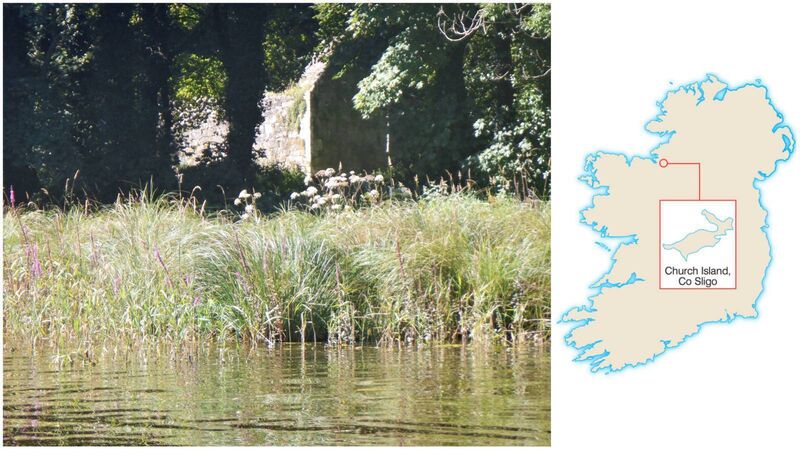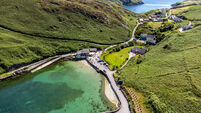Islands of Ireland: This island is reputed to have treasure guarded by a serpent

Islands of Ireland: Church Island, County Sligo is 42 acres big. On the island is a structure called the Lady's Bed which has been visited by women hoping to become pregnant
By far the largest island in Lough Gill, the 42-acre Church Island is so big that it possesses its own woodland of native species, ranking it along with its arboreal counterparts along the shores of the lough. Hazlewood to the west and Slishwood to the north, are two of the more spectacular instances of native woodlands.
Passing by the island on your kayak or on the tour boat that plies its trade from Sligo Town to Parke’s Castle, you can’t help but imagine that something or somebody lurks deep in the woods. A summer kayak trip there saw a landing on the eastern side at a small jetty with purple loosestrife and cow parsley providing a colourful welcome at the shoreline where the algal waters were very green.
The island looks like an supside-down map of Italy, with its own 'heel' and 'toe'. The western part of the island had a small number of dwelling houses where the Gallagher family lived until the mid-20th century. The census records nine people living there pre-Famine.
However, it is the island’s church which is by far the largest manmade structure there. The original smaller church dated from the sixth-century and was founded by Lommán of Trim and replaced much later in the medieval period. One writer opined that while we know virtually nothing of Lommán it is instructive to “visit their haunts and while there, try to contrast their prayerful, contemplative lives with the mad world in which it is our lot to be cast”.
In 1791 Francis Grose explained that pregnant women would enter “Our Lady’s Bed”, on Lough Gill's Church Island #Sligo, and “turn thrice around, which they believe prevents their dying in labour; at the same time they repeat certain prayers". Full story: https://t.co/FXWTfZHmEa
— Irish Heritage News (@heritage_irish) November 4, 2022
There is a graveyard attached to the church and a structure called the Lady’s Bed to which women hoping to become pregnant would visit and pray.
In the early 15th-century the island was home to what that writer describes as a family of poets and historians who had collected a large number of manuscripts. These were the O’Cuirnins who served the O’Rourke clan which dominated the region for several hundred years.
Tragedy struck Church Island in 1416 when a massive conflagration, apparently accidental, consumed the church and destroyed O'Curnin's manuscripts, a book known as the Leabhar Gearr and multiple other documents including foreign manuscripts. According to the Annals of the Four Masters, O’Cuirnin’s harp and ornamental cup were also destroyed.
A priceless heritage gone up in smoke.
Whether it was the possessions of O’Cuirnin or other church artifacts is unknown, but Church Island was also reputedly the source of hidden treasure. And in case anyone wishes to seek it out, beware that legend has it that it is “guarded by a serpent which lies beneath the large stone which covers the crock of gold”. The legend states that a life must be lost before the treasure can be recovered. A newspaper report gave its view that it “would seem a simple island to search from end to end and as a matter of fact this has been attempted, but an unforeseen ‘something’ invariably occurred and stopped the work. One such event in the early 20th century saw two botanists in search of rare mosses and ferns on the island when a thunderstorm broke and they fled the island, “their lifeless bodies were found the next day”.
Late 18th-century drawing of the church on Church Island, Lough Gill, Co #Sligo, by Italian draughtsman Angelo Maria Bigari. It shows this late medieval church already roofless & partly ruined. Read about the island's #history #archaeology & #folklore here https://t.co/4l8u9NJcWo pic.twitter.com/QkgFnkYS0h
— Irish Heritage News (@heritage_irish) September 27, 2022
Church Island found its way into a diverse collection of drawings of attractive sites in the west of Ireland in the 18th century. Italian landscape artist, Angelo Maria Bigari, sketched the island to add to his collection including the abbeys at Sligo, Burrishoole and Boyle.
There are many Church Islands in the country indicating our rich ecclesiastical history. They include islands in Lough Beg, County Derry; Lough Cara, County Mayo; Lough Currane, County Kerry, and the amazing one that has its own miniature monastery adjacent to Valentia Island, County Kerry. Lough Gill’s Church Island (also known as Inis Mór) has a number of satellite islands too: Monk’s Island, Fairy Island, Swan Island, and the curiously-named Black Tom’s Island.
The island has had at least one famous visitor: WB Yeats took many excursions to the lake with family and friends.
: For tours on Lough Gill: roseofinnisfree.com
: Sligo Champion, 22/03/1930 and 01/11/1930









